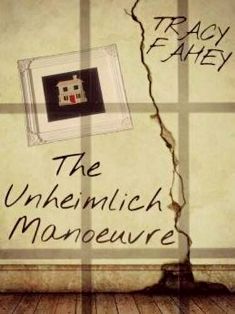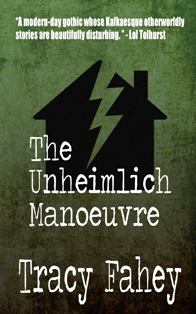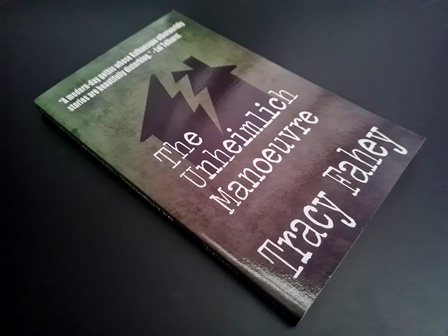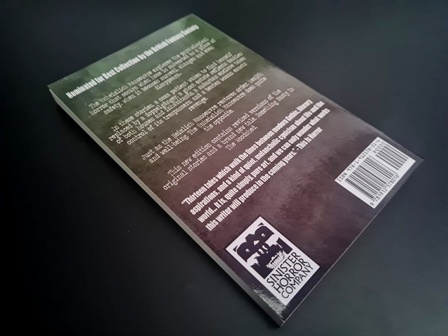
Original Version

Updated Version
First published back in July 2016 as a limited edition collection by Boo Books, Irish author Tracy Fahey’s short story collection ‘The Unheimlich Manoeuvre’ was later released by The Sinister Horror Company in March of 2018 containing revised versions of the original stories, along with the brand new tale ‘Something Nasty In The Woodshed’. In March 2020 an expanded deluxe hardback edition of the collection was released by The Sinister Horror Company entitled ‘The Unheimlich Manoeuvre: Deluxe Edition’ (2020), which contained (amongst other bonus material) the additional essay ‘Creative Evocations Of Uncanny Domestic Spaces,’ along with five additional stories, and complete story notes for all the tales featured in deluxe edition.
For those who already owned the 2018 rerelease, a chapbook entitled ‘Unheimlich Manoeuvres In The Dark’ was also released in March 2020, containing the additional material that was included within ‘The Unheimlich Manoeuvre: Deluxe Edition’ (2020). This review is for the standard version of The Sinister Horror Company release.
Introduction – Cate Gardner – 2 Pages
British horror and fantastical author Cate Gardner opens up the collection with a short introduction detailing her impressions of the stories, mentioning Fahey’s key inspirations, and Gardner’s personal favourites from the collection. For an opening introduction it does exactly what it sets out to do:- it whets the appetite and rolls out the black carpet for the stories to come.
Coming Back – 13 Pages
She woke not knowing who or where she was. Drugged up, half-waking, the first few days after waking from the coma were spent in a perpetual swoon. Through the hazy fog in her mind she remembered occasionally waking at night to find a man by her bed. Often, he would walk up and down the hospital room, staring at all four beds in her room. That was as far back as her memory would extend. Before that nothing. No memory of her former self whatsoever. The not knowing was the worst. Not knowing her past. Not knowing what had put her in a coma. Not knowing who she was...
The concept for the short isn’t exactly ground-breaking stuff. But that’s not the point here. It’s how the story is told. The emotional response that Fahey manages to project upon the reader through the lost and scared voice of our troubled narrator. It’s a quiet yet unsettling read, cloaked in suggestive notions of something just out of reach. And it works.
The short was originally published in the short story anthology ‘Girl At The End Of The World: Book One’ (2014).
Ghost Estate, Phase II – 9 Pages
One minute her life was filled with the hustle and bustle of a busy family life, the next it’s all gone. The door on that old life closed forever. The loss was crippling. She knew she needed time to see this thing through. To get past it. Which was why her friend’s home in the ghost estate was perfect for her. Located in the West of Ireland, the unfinished estate offered a place to be by herself for a while. To lick her wounds and get herself back on track. The house was located in the Phase I area - the first phase of the estate’s build. The finished part. It had a few occupied houses, with occupants who kept themselves to themselves. Phase II was different. Phase II was an uncanny mirror of Phase I but left to solitude. No one lived in Phase II. It was supposed to be off limits. But she went there sometimes. She’d walk the empty streets and peer through the windows of the empty houses. Phase II was a place that soothed her. But it appeared she wasn’t the only one who visited the ghost estate…
The idea of these empty, half-built skeleton estates offers such potential for a devilishly creepy horror. In her introduction, Cate Gardner makes reference to this particular story, telling us what Tracy said about the reality of these ghost estates in Ireland. The story is one which feeds off the unsettling atmosphere of one such place. A half-built estate that’s been left to ruin. It’s a great set-up for the story, and one which Fahey manages to depict with a masterful sense of eerie isolation. Upon this Fahey adds a ‘Don’t Look Now’ (1973) style of quietly sinister horror. Well, more a creeping suggestion than full blown horror. It all works relatively well, although the conclusion delivers a tad too much of a ‘Twilight Zone’ twist to really suit the tale.
The short was originally published in the short story anthology ‘Hauntings: An Anthology’ (2014).
Walking The Borderlines – 10 Pages
Their meeting had been one of chance, whilst she was in her twenties travelling around Europe. They met in the lobby of a Parisian hostel, the moment their eyes met they clicked. His name was Charles Anderson. They both had so much in common. But their connection was more than similar tastes. People didn’t like it when you said and did strange things. Like being able to hear voices from the other side. But Charles understood. He’d experienced the same. He knew of the voices, and the people that appeared in the dead of night. He knew how to walk the borderlines…
Let’s be honest, people who claim to have paranormal abilities, who can apparently tune into frequencies we can’t, are always going to pique our interest. After all, nothing about the matter has ever been one hundred percent proven or disproven. That my friends, makes for some damn fine supernatural storytelling. Which is exactly what Fahey’s homed in on here. We’re talking two individuals whose chance meeting brings them together and their shared ability to see things others can’t. The narrator’s reminiscing voice about their meeting and the subsequent paranormal vision is what makes the story. There’s so much sadness enveloping the tale. The words are always erring towards our narrator’s sorrow. How her unusual ability has tormented her. Brought such uncertainty. Such misery. Such loss. It’s a well written short, although perhaps that little too undeveloped to properly fulfil the gradual build-up it had established.
The short was originally published in the short story anthology ‘Darkest Minds’ (2015).
Long Shadows – 11 Pages
Sophie Scorton can’t face another night of the nightmares. She’s afraid to sleep. Exhausted from staying awake. When she does sleep, she’d wake gripped in panic and breathless from the anguish of the nightmare. She knew she needed help. So, she turns to therapy. Returning to see Doctor Smith. She trusts him. She also knows he won’t charge her for the session. Old times sake and all that. Finally she can unload her dreams onto someone who may be able to help. Finally she can face her fears and hopefully find a cure…
Recurring nightmares are another textbook subject for a classic horror story. Indeed, the whole ‘A Nightmare On Elm Street’ franchise was built around them. For her short, Fahey toys with the haunting visions of this young woman’s nightmares, depicting each one in stark, vivid detail. This in itself forms the backbone to the story. Of course, that’s not the end of the story. There’s a reason for the nightmares. And the sharp twist-ending Fahey delivers is swift and tormenting, reminiscent of the opening chapters to Barker’s ‘Nightbreed’ (1990).
The short was originally published in the ‘Where Dreams And Visions Live: Anthologies Of The Heart – Book One’ (2014) anthology.
The Woman Next Door – 12 Pages
Ever since their baby, Jack, had arrived, Laura’s life had been a chaotic maelstrom of motherhood. She was struggling to cope with it all. The constant changing of nappies, feeding, cleaning and looking after him. Her husband, Sean, wasn’t much help. He went off to work, returning in the evening as Jack went down for the night. But it was their new neighbour that made it that much harder for her. Laura would watch her from out of their upstairs window. Watch as this perfect and pristine young woman went about her day, looking after her own perfect little baby. The woman was everything Laura wanted to be. But she was everything Laura was not. And so, Laura’s obsession with her grew…
For anyone who’s gone through those initial few months of being a young parent, this story will sing from the very same songbook as you can probably still vividly recall. Those tired, manic first few months, where your life is thrown into complete turmoil thanks to the arrival of your baby. Fahey captures this perfectly. Every exhausted and exasperated sentence is an echo of those tiring first few months. Reading this short will send you right back there – for better or worse. It’s an absolute testament to Fahey’s writing how spot on she seems to get it. Those emotions. The irrational resentment that simmers in your belly. However, here Fahey takes all those irrational thoughts and throws them into a pressure cooker so we can stand back and watch the madness bubble up and eventually explode. Oh, what a story.
Tracing The Spectre – 12 Pages
They were a team of international artists collaborating on two twenty-four hour projects involving paranormal investigations in Ireland and the US. The first project had taken place in Tennessee earlier in the year. Now they were set to undertake the second project at the gothic Knocknamara Castle in Ireland. Incorporating the use of performance art, they were aiming to tie together witch legends that had stained the past of the two locations. In Ireland, there was an alleged witch who’d been stoned to death outside the castle for supposedly setting a curse on the landlord’s castle. This small team would see if they could find any lasting presence of the with. Any unusual sounds, any transitions from light to the pits of darkness…
Classic set-up. Classic premise. We’ve all read a heap of this type of haunted house/mansion/castle story. To be honest, this one’s much like many of the others you may have come by. The usual paranormal investigation setup trying to capture some midnight spooks. The textbook cold and tired crew wishing they were anywhere but in a dark and eerie castle. Although the obnoxious performance artist Skye is a nice touch, as is the voice that Fahey delivers in narrating the story. But other than that, to be brutally honest, it’s pretty much been done to death – with James Herbert’s ‘Haunted’ (1988), Shirley Jackson’s ‘The Haunting Of Hill House’ (1959), and Richard Matheson’s ‘Hell House’ (1971) being the collective bar by which all other stories of this nature should be judged.
Papering Over The Cracks – 21 Pages
Donna couldn’t believe it when they found out they’d be buying her great-aunt’s old Georgian mansion. Of course, it would need lots of work doing to it. But Mark knew what he was doing. He was an architect. And it was because of this that he chose how the whole house would look. He chose the style of every room, but one. The attic was to be hers. Hers to renovate. Hers to choose what it would become. However, during her renovation of the attic Donna found something strange. Under the wallpaper on the attic wall she uncovered a drawing of a face which looked just like her. Although the face had blank, terrified eyes and a gaping mouth locked in a perpetual scream. Its physical presence acted like a magnetic current for her thoughts, drawing them endlessly back to the attic room. Over the following days she became obsessed by the room. Obsessed with the drawing. Obsessed with the screaming face that looked just like her…
You’ve got to love the way Fahey tells these modern-day gothic stories. The quietly eerie prose she employs to weave those first delicate tendrils of an unsettling gothic horror. For this story we have a young couple renovating their dream house, and in it, finding a strange and unnerving history, hidden behind the outdated décor. The puzzling mystery lurking in the shadows of the tale ensnares you from early on. And from then on you’ll become caught up in the increasing friction between the couple, until the sudden, dramatic twist-ending, seals the deal with a textbook Boris Karloff’s ‘Thriller’ (1960 – 62) signoff.
Two Faced – 9 Pages
They’d gone on holiday to Vienna. It was the sort of holiday Kate loved. Everywhere they went the place was steeped in history. Row after row of beautiful architecture. But Kate knew Alex wasn’t enjoying himself. He never enjoyed the things she did. For her, a small acorn of doubt about their marriage had been planted. The idea was scary, but plausible. For Alex though, he had entirely different things on his mind…
This one’s not so much a gothic horror as it is a representation of a marriage that’s bound for failure. The title alone “Two Faced” gives the reader a fair idea of where the story’s going. What’s interesting about the story is in its construction and delivery. In essence you have a short period of time in which the couple search for somewhere to eat in Vienna and then a visit to the Heiligenkreuz monastery, that’s played out twice. First from the first-person perspective of emotionally tired Kate, and then the exact same period of time told from the perspective of Alex. But it’s what’s going on inside their heads that’s the interesting part. Their mind’s eye versions of the situation and how they interpret each other’s responses. It’s interesting and oddly compelling reading. Although for better results it could perhaps have continued a tad further, with more fleshing out of the aspects to this sadly failing marriage.
Something Nasty In The Woodshed – 14 Pages
In the days that followed the discovery that changed her life, Teresa Philips had stayed hidden away in her house. Ever since she opened the woodshed door, she’d barely slept, despite the copious sleeping pills. Outside the journalists waited for her to make an appearance. To show her face. But she couldn’t. The shame was too deep. They would never understand. And when she did finally sleep, in her dreams she would fight to wake, but a heavy dread kept pulling her back down, back to the shed, with its blood and stink and mess. And the girl’s face. Her dirty, bloody, frantic face…
Holy shit is this a fucking awesome story! So many strong and powerfully evocative aspects. Such as its construction. The way it’s entirely written in bitter hindsight, over the ten days that followed ‘the discovery’. But the telling of the story isn’t in a linear timeframe. It cleverly jumps back and forth to keep the unravelling of the true horror going until the end. Then there’s the unique perspective used. No one ever looks at the perspective of the “other party” to a horrendous crime. The loving husband or wife to the vicious killer, who has to try and cope with the horror of finding out their partner’s dark secret. And the repercussions. God the repercussions. They get their own life sentence from it. But there’s even more to this short story than all that…as if that wasn’t enough already. There’s the hellishly brutal horror behind it, the suspense that escalates to heart-thumping proportions. Still it doesn’t end there! Fahey takes it somewhere even darker. More terrifying. More unnerving. Somehow, somewhere more human. And that’s the moment when you realise you’ve read something truly special. That final twist. That cold, cruel understanding. Absolute genius. This is undoubtedly the standout story of the collection.
The short was originally published in the ‘Onyx Neon Shorts: Horror Collection 2015’ (2015) anthology.
Sealed – 14 Pages
Her life was contained within the four walls of their house. It had been this was ever since her mother passed away. Ever since that fateful wintery night. Her mother had wanted to see her dance. See her perform on stage. Now she was gone forever. Her distraught daughter left in the care of an uncle. An uncle who didn’t seem to care. Who was sick of how she was. Tired of her never leaving the house. But she couldn’t. She couldn’t go out there. Just couldn’t…
Here we have another non-horror tale packed with intrigue. In it we have a young girl who suffers from agoraphobia and obsessive compulsive disorder. We witness her daily rituals. Her obsessive need to follow the exact same routines. But most intriguing is the agoraphobia, and how she came to inherit it. I use the word inherit very purposefully, because that’s pretty much the suggestion of the story. How the condition seems to have been passed down through the family. Like a strange family trait. It’s an odd notion which gets you thinking. And seeing it from behind the eyes of the sufferer, affords a uniquely compelling perspective. Very well considered and wonderfully executed.
A Lovely Place To Live – 16 Pages
She was over the moon when she found the house. It was so much nicer than the place she’d had in London. Located in an elegant middleclass suburb on the outskirts of a large Irish town, the house was one of five along the prettiest street of them all. A uniform and well-maintained cul-de-sac, where all the lawns were well-kept, the windows sparkling, and the hedges perfectly trimmed. It was truly idyllic. And the welcome she received from her neighbours was equally as pleasant. They seemed to like the idea of her being a teacher. A respectable job to have in their perfect little corner of the world. A lovely place to live, which the residents would do anything to preserve. Anything…
This wonderfully well-written black comedy feels like a cross between the neighbourhood ‘Edward Scissorhands’ moved into, and something you could imagine Shearsmith and Pemberton writing as part of their ‘Inside No. 9’ series. There’s not really any creepiness, or gothic horror. Nor is there any real suspense or grisly thrills as such. However, the real joy in the tale is with the way the story is told. The colourful voice and enchanting backdrop to it all. To be honest, the ‘twist ending’ probably won’t come as a huge surprise to most. It’s pretty guessable from relatively early on. Nevertheless, there’s plenty of intrigue to be had in the tale. And despite the predictability with the ‘would be surprise twist’, it’s still a damn entertaining read.
I Look Like You. I Speak Like You. I Walk Like You. – 13 Pages
They’d been separated after the death of their mother. Twins taken into foster care. They’d not seen each other since then. Forgotten their past. Forgotten their childhood. Forgotten each other. Twenty-five years had passed since their separation and now Stella was searching out her long-lost twin sister. Although Stella’s life was tough. Her husband, Harry, beat her. If the flat wasn’t tidy enough, if she bought the wrong milk, if he was just in a bad mood – she’d pay. Recently she’d begun to see her death written in his face. One day, she knew the hands that once held her in love, would end her life. Which is why she finally reached out. Finally made contact with Susie. Her beloved twin sister. They were the same in almost every way. But their lives were different in every possible way…
And here we have another incredible read. Powerfully evocative, gut-wrenchingly cruel and disturbingly real. In the short Fahey paints a terrifyingly convincing picture of domestic violence. The hellish existence of a broken young woman living with a violently abusive partner. The torment endured and mindset of the victim leaves you feeling deathly cold. But there’s much more to this tale than just a depiction of this horrendous abuse. That’s merely the catalyst for where Fahey’s leading the tale. The hard-to-swallow path it takes us. And ultimately, the magnificently executed twist ending. And what a twist it is.
The short was originally published in the ‘Jotters United Litzine: Issue 10’ (2015) free online e-zine.
Looking For Wildgoose Lodge – 6 Pages
Her grandmother used to tell her the story. Each time she heard it, she’d wonder why she always asked to hear it again. Such a terrible, heart-wrenching story about an Irish family - the Lynch’s - who were murdered by a cruel group of soldiers. The family house had been set alight whilst they slept inside. Their baby impaled on a bayonet, as it was thrust from a burning window. The story disturbed her. But stayed with her. Until she found it to be true. And then she knew she had to go there. Find the house where the Lynch family met their end in an inferno of flames. A sombre pilgrimage to Wildgoose Lodge…
Ending the collection we have a heart-wrenching story, told through the eyes and memories of a woman who feels compelled to find the place of a terrible crime that her grandmother used to tell her the story of as a little girl. Like me, after reading Fahey’s short, you’ll probably be drawn to investigating if there’s any factual background to the harrowing tale. Indeed, if you search for “The Burning of Wildgoose Lodge”, you’ll find a whole host of information about the horrendous murder that occurred in the townland of Reaghstown, back in October of 1816. It’s a harsh and terrible story, that’s wrapped up in a delicately delivered narrative. The author’s connection to the story feels evident. The prose makes you believe this is her story. A part of her. Whether that’s true or not, I don’t know. But the apparent emotional tie makes it that much more powerful. Truly heart-wrenching.
The short was originally published in the ‘Impossible Spaces’ (2013) anthology.
DLS Summary:
All in all, ‘The Unheimlich Manoeuvre’ is an intriguing collection delivering a mixed bag of stories – some moderate in the substance, others incredibly strong with a number of evocative aspects to them. It’s certainly very well written, with a haunting modern-day gothic allure to each offering. There are definite standout stories, such as ‘I Look Like You. I Speak Like You. I Walk Like You.’, although ‘Something Nasty In The Woodshed’ is the undoubted highlight of the collection. Others, although intriguing and provocative in their premise and prose, can feel a tad too stunted and reserved with their final execution. That said, the collection is a damn fine read, especially for cold, dark nights when you’re wrapped up in a blanket by a crackling fireplace.
The collection runs for a total of 165 pages.

© DLS Reviews








